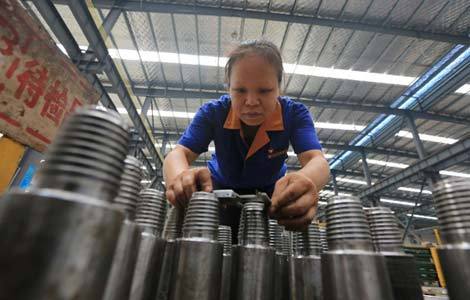International cotton contract in the works
Updated: 2013-07-16 10:51
By Caroline Berg in New York (China Daily)
|
||||||||
|
Ben Jackson, president and COO of ICE Futures US, kicks off a daylong cotton trade conference in New York on Monday. Caroline Berg / China Daily |
In 1784, the US exported its first load of cotton to London. Weighing 400 pounds in eight bags, British authorities declared it contraband because they believed the US couldn't have produced that much cotton for export.
"Wow, have times changed," said Ben Jackson, president and COO of ICE Futures US, who shared that and other historical facts at a daylong cotton conference in New York on Monday.
Jackson warmed up the audience of cotton-industry stakeholders from the US, China and India by offering prizes of golf balls for a few trivia questions.
"Fast forward to 2010, can anyone tell me what were the approximate US exports to China in cotton?" Jackson asked the audience.
The correct answer: almost 1.2 million metric tons of cotton, representing $2.2 billion in value. In 2001, US exports to China amounted to 63,000 tons of cotton at a value of $56 million. Total cotton consumption in China for 2013 is expected to be 7.7 million tons.
"Data on US exports to China in just over a 10-year period of time [reveal] how significant of an impact China has had in terms of consuming US grown cotton," Jackson said.
Over the past decade, China has encouraged cotton growers to readjust their product mix; introduced, developed and commercialized more high-quality, productive and marketable varieties of cotton from abroad; and popularized advanced cotton planting techniques, according to a presentation by Hua Liu, general counsel for the China National Cotton Reserves Corporation (CNCRC).
In March 2011, the Chinese government enacted the Policy on Provisional Purchase and Storage of Cotton, which Liu said has helped stave off fluctuations in cotton output and effectively regulated a stable cotton-cultivation area of about 11.5 million to 13.2 million acres.
"Given the limited cultivation area in the country, the competition for arable land between cotton and grains has always been an issue," Liu said. "We will [continue] to actively import cotton from abroad to replenish the national cotton reserves to meet the demand of China's textile industry."
Liu said he expects the 10-year-old CNCRC, which in the last few years became China's largest cotton warehouse and distributor, will continue to work on improving its technological and managerial capabilities across the board - purchase and storage of imported cotton, rotation of cotton reserves, and its cotton logistics system - through reform and innovation.
"We are working toward becoming more transparent and open for the international community," Liu said at the conference. "Over the next decade we hope to deepen our collaborations and share resources to enable more win-win results."
Jackson said the changes and trends in the US-China cotton trade led to what has so far been a yearlong exchange between cotton market stakeholders worldwide to discuss the development of a new international cotton contract.
"While we haven't finalized the specifications for that contract yet, we think that it's important in acknowledging the several changes over the last several decades to launch a new contract," Jackson said.
Jackson said the current Cotton Number 2 contract, which regulates cotton delivery standards based on weekly market fluctuations, would remain in place as the benchmark for the international trading of cotton. The proposed new contract would complement Cotton Number 2.
"[The new contract] has some very specific changes built into it to reflect commercial realities and commercial changes that have happened over the course of the past couple of decades," Jackson said.
The launch date for this new contract hasn't been determined; specifications must be nailed down first.
The No 1 goal that Jackson said he and his team hope and expect to get out of this new contract is a greater understanding of the current influence China has in the cotton market, as well as what this influence may be in the future, to inform the company's product-development efforts and its cotton contracts.
carolineberg@chinadailyusa.com
(China Daily USA 07/16/2013 page2)

 Obama urges restraint amid protests
Obama urges restraint amid protests
 Putin wants Snowden to go, but asylum not ruled out
Putin wants Snowden to go, but asylum not ruled out
 Apple to probe death of Chinese using charging iPhone
Apple to probe death of Chinese using charging iPhone
 Investment falters as industrial activity flags
Investment falters as industrial activity flags
 Rape victim's mother wins appeal
Rape victim's mother wins appeal
 Reproduction of 'Sunflowers' displayed in HK
Reproduction of 'Sunflowers' displayed in HK
 Land Rover enthusiasts tour the world
Land Rover enthusiasts tour the world
 US star sprinter fails drug test
US star sprinter fails drug test
Most Viewed
Editor's Picks

|

|

|

|

|

|
Today's Top News
China calls for new talks on Iran nuclear issue
Global warming may largely raises sea level
Putin wants Snowden to go, asylum not ruled out
Top foreign study destinations for Chinese
Trailblazer reaches out to inmates on death row
Air crash payouts could differ
Cabinet promises more funds for smaller firms
Capital prison tests therapy on inmates
US Weekly

|

|







